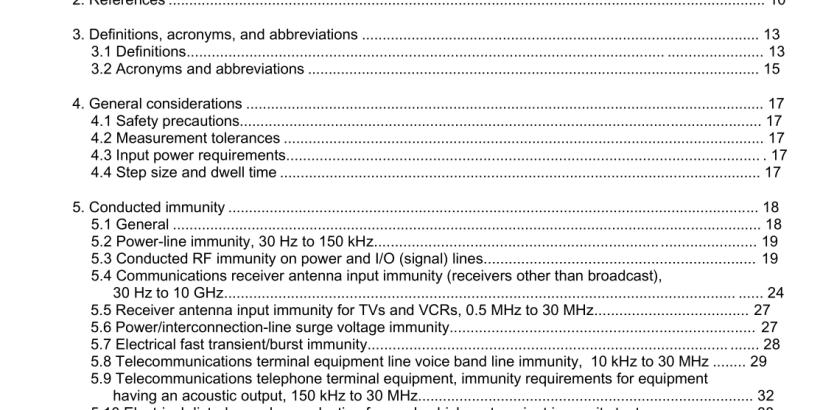ANSI C63.15-2017 pdf download.American National Standard Recommended Practice for the Immunity Measurement of Electrical and Electronic Equipment
5.3.1 General
This test method is used to verify the ability of the EUT to function as intended with modulated RF common-mode signals that might be present on power and I/O lines. There are two widely used standards for this type of conducted immunity testing; military (MIL-STD-461G-2015) and commercial (IEC 61000- 4-6). The choice is contractual, as required by the customer or dictated by the installation environment. With the recent emphasis on commercial off-the-shelf (COTS) equipment, even for military applications, the acquisition requirement usually stipulates the type of testing needed. Military testing injects currents into undefined (i.e., as installed) loop impedances. The test signal is inductively coupled using a current probe. Faraday’s law predicts induced voltages in such a loop circuit from the resultant current flow, with the voltage drops dependent on the various impedances present. The test method requires checking for resonant, infinitesimally small impedances, then limiting the injected current in these cases. Interfering currents are induced into all wires at a connector interface simultaneously (in common mode), which simulates actual use. Auxiliary equipment (AE) shall be decoupled as required to preclude malfunctions. Testing is required on intact complete power cables, and on power cables with the neutral or grounded conductors removed, to evaluate common-mode coupling to configurations that might be present in different end-use installations. In some end-use installations, the neutral or grounded wire is routed along with the line conductor, while in other cases the neutrals or grounded conductors are tied to the grounded system structure near the utilization (load) equipment. The entire grounded system structure is used as the power return path. Commercial testing couples voltages using coupling-decoupling networks (CDNs) on power and I/O wiring in common-mode. The use of the CDNs sets the loop impedance so that the test voltage levels are maintained (no over-testing when using CDNs). The decoupling section helps preclude malfunctions, due to the interfering voltages, of the AE used to monitor EUT acceptance. Interfering voltages are coupled onto all wires of an interface simultaneously, in common-mode, to simulate actual use. Inductive coupling or an electromagnetic (EM) clamp can also be used for commercial testing as an alternative to CDNs; this can be a preferable method if a CDN is not available, e.g., for a custom I/O cable. Each coupling method requires a “level-setting” procedure to determine the required drive level for that coupling method, test level, and test setup. This “drive table” is then played back by the computer (with 80% amplitude modulation (AM) applied; 1 kHz or 400 Hz) during the test run, with an appropriate dwell time (usually 2 s) at each frequency, and the performance of the EUT is monitored by decoupled AE for failures.
5.3.2.1 General
For military testing, use the test procedure given in Method CS114 of MIL-STD-461G-2015 from 10 kHz to 200 MHz. The procedure requires both inducing a current and measuring such current, to preclude over- testing into zero (infinitesimally small) impedance loads from occurring. Note also that during playback, the limit on induced current is not the calibration curve, but instead is defined in 5.12.2 of MIL-STD-461G- 2015. These limits can be tailored to the EUT based on actual usage environment. For commercial testing, IEC 61000-4-6 can be used over the frequency range 150 kHz to 80 MHz (typically) or as high as 230 MHz. CDNs are now available for almost every type of I/O line, including Ethernet. The use of CDNs is required if they are appropriate for the line being tested. A level-setting procedure is required for each CDN. All power and I/O wiring should have input-terminated CDNs before level-setting or testing begins on any of them. In the case of some complex lines, such as with medical products, the product may not function due to CDN impedance or use of a CDN may not be appropriate, then use of the EM clamp is appropriate.ANSI C63.15-2017 pdf download
